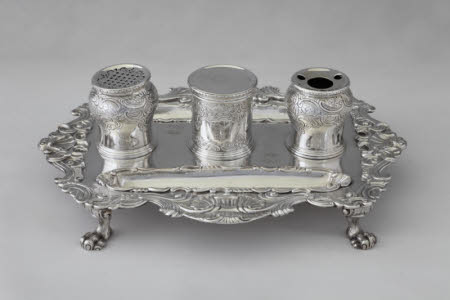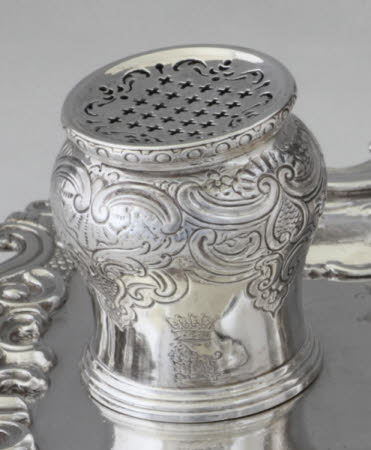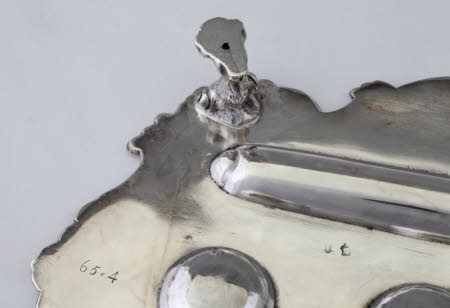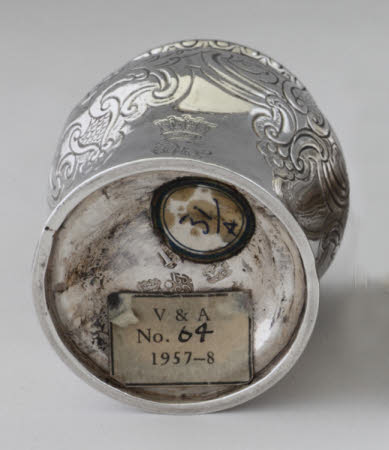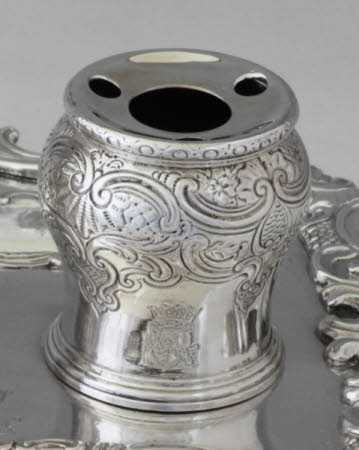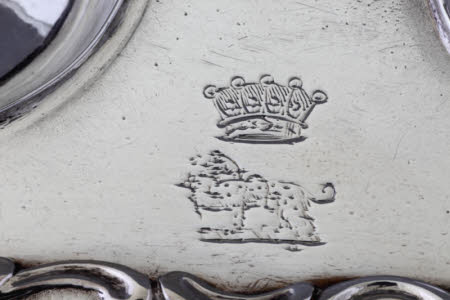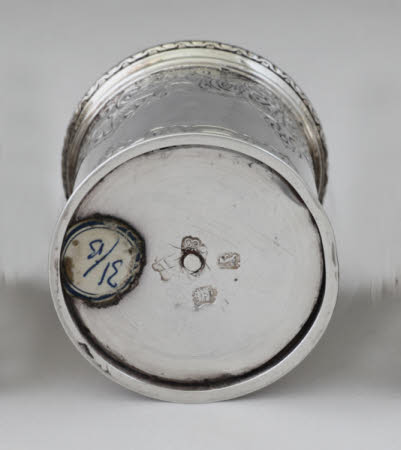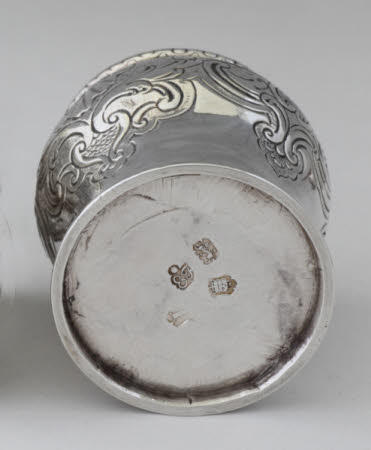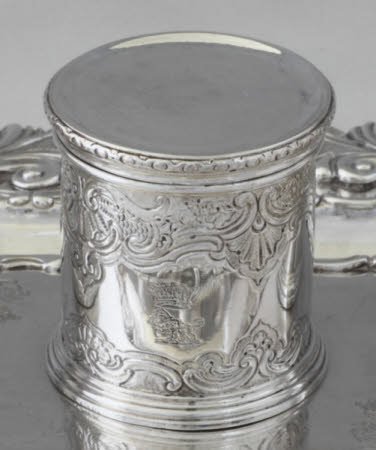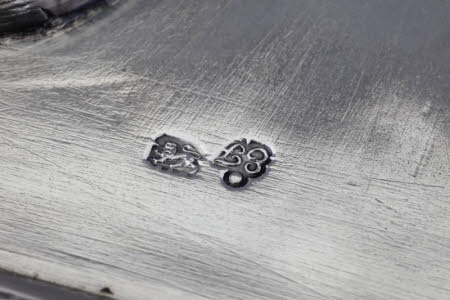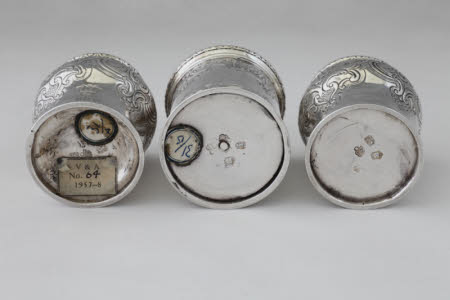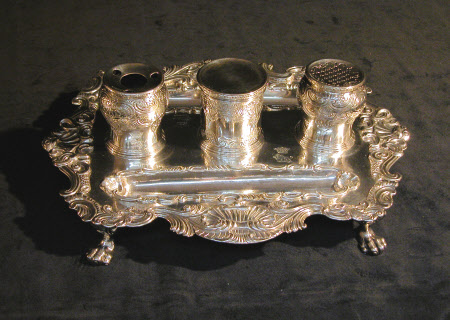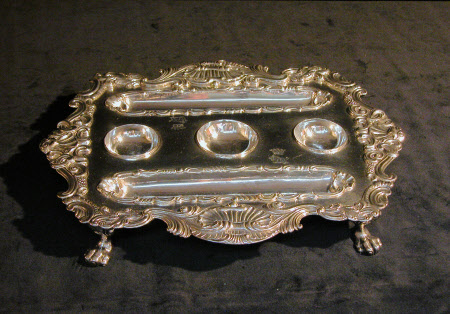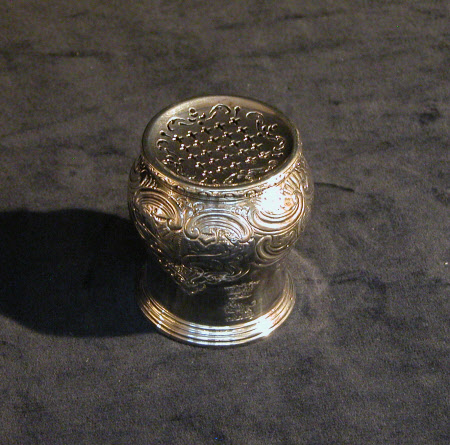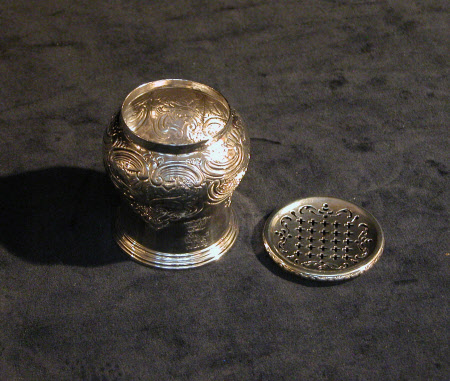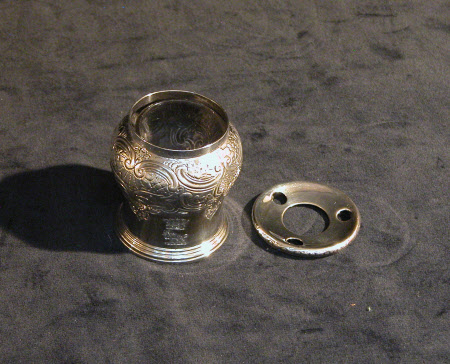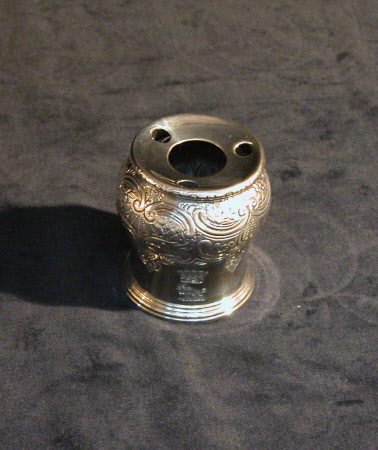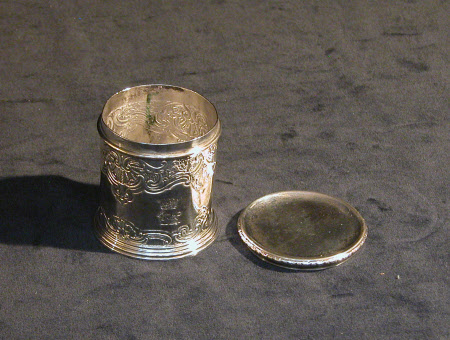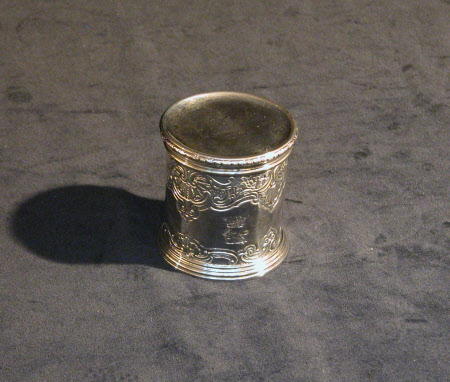Inkstand
Edward Feline (fl.1720)
Category
Silver
Date
1746 - 1747
Materials
Sterling silver
Measurements
9.5 x 32.1 x 25.7 cm
Place of origin
London
Order this imageCollection
Ickworth, Suffolk
NT 852075
Summary
Inkstand, sterling silver, by Edward Feline, London, 1746/7. The rectangular stand is of sheet silver with a cast and chased shell-and-scroll border. The two pen wells, which are raised and soldered in place, have cast and chased shell-and-scroll borders. The hemispherical, convex stays for the pots are also raised and applied and the scroll and lion’s paw feet are cast and chased. Each of the three circular pots is seamed, the ink and pounce pots embossed to produce the bulbous part of the upper body and the seal pot having a moulded wire at the top. All three have a moulded wire at the base and are flat-chased with shell and scrollwork, the middle only left plain. The lids are cast and have chased running bands of open ovals on their rims. The lid of the ink pot, which retains a clear-glass cylindrical liner, has a large central hole and three smaller surrounding holes for the pen. The pounce pot lid is pierced in a trellis pattern surrounded by scrolls. Heraldry: The stand is twice engraved, off-centre behind the pen trays, with the Hervey crest beneath an earl’s coronet. Each of the pots is engraved once with the same. Hallmarks: Fully marked on the underside of the stand and each of the three pots with date letter ‘l’, leopard’s head, maker’s mark ‘EF’ in italics beneath a pellet (Arthur Grimwade, London Goldsmiths 1697-1837, 1990, no. 587) and lion passant. The seal pot and pounce pot are also marked on the underside of their lids with the maker’s mark and lion passant. Scratchweight: ‘65=4’
Full description
This is probably the inkstand which George Hervey, 2nd Earl of Bristol (1721-75) had with him as envoy at Turin and ambassador at Madrid and it would also have been used in his subsequent political career. His many surviving letters would thus have been written from it. In the absence of evidence of any earlier purchases of plate or of re-engraving of the crest and coronet it is probable that it, like the kettle waiter (NT 852071.4), formed part of his first recorded commission from Kandler in 1751. The great majority of inkstands were much plainer in appearance than Lord Bristol’s, writing generally being undertaken in the privacy of the chamber or closet and not therefore requiring overt display. The Earl might, therefore, have had his intended diplomatic career in mind when ordering this more florid example, conscious of the need to closet himself on a regular basis with the envoys of other states and the ministers of the court to which he had been assigned. Early eighteenth-century inkstands, where not of the casket type, tended to be in the form of deep trays, like that of 1716 by Isaac Liger surviving at Dunham Massey.[1] Though this style persisted well into the century the more fashionable models gradually flattened out until they scarcely had a raised outer edge at all, as on this example. From the late 1730s several makers fully embraced the Rococo and produced wildly naturalistic forms, such as that at Chatsworth by Paul Crespin of 1739 with pots masquerading as conch shells, a coral as a pen rest and divers other shells piled up to form the tray.[2] Such creations were, of course, exceptional but the rectilinearity of earlier stands was often now broken by at least a shaped outline and in some cases the addition of elaborate cast borders. The Ickworth stand has particularly extensive cast ornament, the broadly triangular flanges packed full of shells and C-scrolls, the pen trays being embellished to match and the whole being supported on bold, clenched lion claw feet suitable to the substantial weight. A precedent for the flanged form, which is rare, exists in an inkstand of 1732 by Paul de Lamerie,[3] though in that case the detail of the casting is Régence, being a reuse of the moulds for the handles of his 1724 Scarsdale epergne dish (NT 852064.1). The flanking pots of the Ickworth inkstand would have been for ink and for sand or powder (also known as pounce) for preparing unsized paper and for blotting after writing. The central seal pot would have contained wafers which were an alternative to wax for sealing. One of a handful of what are probably mid-eighteenth-century baize bags, lined with soft cotton and with a cotton tape drawstring, survives for this piece, together with its linen label inscribed ‘One Inkstand’. James Rothwell, Decorative Arts Curator January 2021 [Adapted from James Rothwell, Silver for Entertaining: The Ickworth Collection, London 2017, cat. 27, pp. 104-5.] Notes: [1] Lomax and Rothwell 2006, cat. 43, pp. 101-2. [2] Grimwade 1974, p. 58 and plate 85. For other examples see also plates 84 and 86a and b. [3] Jackson 1911, p. 904, fig. 1181.
Provenance
George Hervey, 2nd Earl of Bristol (1721-75); by descent to the 4th Marquess of Bristol (1863-1951); accepted by the Treasury in lieu of death duties in 1956 and transferred to the National Trust.
Credit line
Ickworth, the Bristol Collection (National Trust)
Makers and roles
Edward Feline (fl.1720), goldsmith
